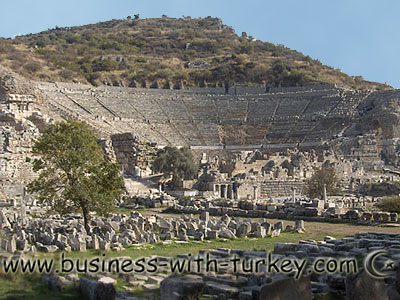
Ephesus is one of the largest, most beautiful and best preserved ancient cities in the world.
The Greek city of Ephesus was built around 1000 BC and soon gained fame as a center of veneration for Cybele, the mother goddess of Anatolia, who was later replaced by Artemis. The great Temple of Artemis, which is one of the Seven Wonders of the World, was located in Ephesus. In ancient times, the city was a very important center, first in the pagan world and later in the Christian world, behind only Athens and Jerusalem.
Ephesus was founded by Lysimachus, successor to Alexander the Great, but it was under Roman rule that it became the most important port in the Aegean. In 133 BC, the city was declared capital of the Roman province of Asia and it was also in the Roman period that the city gained splendid architectural monuments, which became a pride of the population of more than 400,000 inhabitants.
The city, a major commercial and cultural center, went into decline after the silting up of the port. The name of Ephesus was inextricably linked to the initial disclosure of new beliefs in Asia. In apostolic times, Ephesus was one of the cities of the Roman Empire where Christianity was most widespread due to the preaching of the apostles Paul and John. At the end of the first century Ephesus' Church was the first and main community of the Seven Churches of Asia Minor mentioned in the Revelation of Saint John.
Two of the first great Councils of the Catholic Church (431 AD and 449 AD) were held in Ephesus. At 431 AD council the dogma of the Virgin Mary's motherhood and the dual nature of Jesus Christ, as God and as man, was confirmed.
Ephesus was the 5th most populous city in the empire, with 400 to 500 thousand inhabitants. Its population was made up mostly of wealthy and intellectualized people. The region of Ephesus and Miletus, was the birthplace of many philosophers, among them Thales (ca.625-546 BC), Herˇclito (ca. 540 to 470 BC) and Isidorus (540 BC). An inscription in stone was found by archaeologists (perhaps erected by order of the emperor) which rewarded Ephesus as "the most illustrious city in all of Asia".
Alexander the Great, Cleopatra, Virgin Mary, Izabel, Saint John and Saint Paul were some of the people who passed through Ephesus.
The site of the city, as seen today, has been excavated for more than 100 years and most of the remaining buildings date from the Roman period. Among many ruins, we find in Ephesus magnificently preserved buildings, such as the Celsus Library, Hadrian's Gate and the Hellenistic Theater, as well as fountains, streets, Roman baths and commercial agoras.
Selšuk - St. John's Basilica

The city of Selšuk is dominated by a 6th century Byzantine citadel, with 15 well-preserved towers. Near the citadel are the remains of a Byzantine church and a Seljuk mosque. The ruins of St. John's Basilica, built by the emperor Justinian in the 6th century, can be visited after crossing a Byzantine gate. The tomb of St. John the Evangelist, who spent the last few years in the first century in Ephesus, is believed to be in place. Restorations have brought back some of the magnitude of the ancient basilica. In addition to columns and decorations, there are some beautiful frescoes in the chapel.
Temple of Artemis
The Temple of Artemis, which was one of the Seven Wonders of the world, was located in Ephesus. Through excavations in Ephesus, the current location of the temple was assumed to be in different places.
Ephesus Museum
The Ephesus museum in Selšuk, is one of the smallest and best in Turkey. Among the marble and bronze exhibits and beautifully distributed frescoes, there is a sculpture of Artemis, jewelry and various objects in the museum that is believed to have come from the ancient Temple of Artemis. The pagan cult dedicated to Artemis, was famous in antiquity and made Ephesus a place very visited by pilgrims from all over the world.
Kusadasi
The name of the city means "Bird Island", and comes from an islet connected to the mainland by a footbridge. Kusadasi is a frequent port of luxury cruises. It has a pleasant and lively nightlife. The Kervansarayi in a 14th century Genoese fort, reveals the city's commercial origins. |
 gmx.co.uk for more information. Thank you !
gmx.co.uk for more information. Thank you ! gmx.co.uk for more information. Thank you !
gmx.co.uk for more information. Thank you !